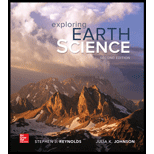
The five principles of relative dating and provide an example for each principle with the help of a sketch.
Answer to Problem 1BYL

Explanation of Solution
The geologic history of an area can be determined by determining the age of geologic units, features, and events. The first step that can be used to determine the age of a rock relative to one another is the method of relative dating. Geoscientists are assigning actual numbers in thousands to billions of years using analytical laboratory methods or isotopic dating to this relative chronology. To compare the ages of different rock layers and to correlate one rock unit relative to one another, fossils are also used. The five main principles of relative dating include the original horizontality, principle of superposition, cross-cutting relation, the occurrence of an older rock piece in younger sediment or rock, and contact effects.
The deposition of most sediments and volcanic units occurred in a more or less horizontal pattern. The principle used to denote this process is known as principle of original horizontality. When the layers are no longer horizontal, it indicates the occurrence of some events after the formation of that layers. The special environments, such as the face of a sand dune or the undersea slopes of a delta are the few exceptions to the principle.
The principle of superposition states that when the deposition of a sediment layer occurs, it overlies the older rocks or sediments. In a sequence of horizontal sedimentary layer sequence, the oldest layer is on the bottom and the youngest layer is at the top.
The third principle of relative dating describes that a younger sediment or rock can contain pieces of an older rock. It indicates that during the formation of a rock or sedimentary deposit, pieces or clasts of older rocks are incorporated into it.
Principle of cross cutting relation states that the rocks are crosscut by fracture. Therefore, the rocks existed there before the formation of fractures. Mainly, there are two types of fractures. They are joints and faults. The slight pulling apart movement of the rock results in the formation of joints and faults are formed along which rocks on opposite side have moved up and down, side to side or as combination.
When magma erupts on to the surface or solidifies at depth, it comes into contact with the pre-existing rock. In both, this setting involves the baking of magma with adjacent rock or chemical alteration of nearby rocks due to the effects of fluids from the magma. Those type of changes that occurred following the eruption or solidification of magma are termed as contact effects.
Want to see more full solutions like this?
Chapter 4 Solutions
Exploring Earth Science
 Applications and Investigations in Earth Science ...Earth ScienceISBN:9780134746241Author:Edward J. Tarbuck, Frederick K. Lutgens, Dennis G. TasaPublisher:PEARSON
Applications and Investigations in Earth Science ...Earth ScienceISBN:9780134746241Author:Edward J. Tarbuck, Frederick K. Lutgens, Dennis G. TasaPublisher:PEARSON Exercises for Weather & Climate (9th Edition)Earth ScienceISBN:9780134041360Author:Greg CarbonePublisher:PEARSON
Exercises for Weather & Climate (9th Edition)Earth ScienceISBN:9780134041360Author:Greg CarbonePublisher:PEARSON Environmental ScienceEarth ScienceISBN:9781260153125Author:William P Cunningham Prof., Mary Ann Cunningham ProfessorPublisher:McGraw-Hill Education
Environmental ScienceEarth ScienceISBN:9781260153125Author:William P Cunningham Prof., Mary Ann Cunningham ProfessorPublisher:McGraw-Hill Education Earth Science (15th Edition)Earth ScienceISBN:9780134543536Author:Edward J. Tarbuck, Frederick K. Lutgens, Dennis G. TasaPublisher:PEARSON
Earth Science (15th Edition)Earth ScienceISBN:9780134543536Author:Edward J. Tarbuck, Frederick K. Lutgens, Dennis G. TasaPublisher:PEARSON Environmental Science (MindTap Course List)Earth ScienceISBN:9781337569613Author:G. Tyler Miller, Scott SpoolmanPublisher:Cengage Learning
Environmental Science (MindTap Course List)Earth ScienceISBN:9781337569613Author:G. Tyler Miller, Scott SpoolmanPublisher:Cengage Learning Physical GeologyEarth ScienceISBN:9781259916823Author:Plummer, Charles C., CARLSON, Diane H., Hammersley, LisaPublisher:Mcgraw-hill Education,
Physical GeologyEarth ScienceISBN:9781259916823Author:Plummer, Charles C., CARLSON, Diane H., Hammersley, LisaPublisher:Mcgraw-hill Education,





